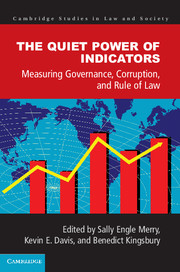Book contents
- Frontmatter
- Contents
- Notes on Contributors
- Acknowledgments
- Introduction: The Local-Global Life of Indicators: Law, Power, and Resistance
- PART I GLOBAL INDICATORS OF GOVERNANCE, CORRUPTION, AND RULE OF LAW
- Part II INDICATORS IN LOCAL CONTEXTS
- 6 Rule of Law Indicators as a Technology of Power in Romania
- 7 Indicators, Global Expertise, and a Local Political Drama: Producing and Deploying Corruption Perception Data in Post-Socialist Albania
- 8 Evaluating the Impact of Corruption Indicators on Governance Discourses in Kenya
- 9 Measuring Labor Market Efficiency: Indicators that Fuel an Ideological War and Undermine Social Concern and Trust in the South African Regulatory Process
- 10 Conclusion: Contesting Global Indicators
- Index
- Books in the Series
- References
10 - Conclusion: Contesting Global Indicators
from Part II - INDICATORS IN LOCAL CONTEXTS
Published online by Cambridge University Press: 05 June 2015
- Frontmatter
- Contents
- Notes on Contributors
- Acknowledgments
- Introduction: The Local-Global Life of Indicators: Law, Power, and Resistance
- PART I GLOBAL INDICATORS OF GOVERNANCE, CORRUPTION, AND RULE OF LAW
- Part II INDICATORS IN LOCAL CONTEXTS
- 6 Rule of Law Indicators as a Technology of Power in Romania
- 7 Indicators, Global Expertise, and a Local Political Drama: Producing and Deploying Corruption Perception Data in Post-Socialist Albania
- 8 Evaluating the Impact of Corruption Indicators on Governance Discourses in Kenya
- 9 Measuring Labor Market Efficiency: Indicators that Fuel an Ideological War and Undermine Social Concern and Trust in the South African Regulatory Process
- 10 Conclusion: Contesting Global Indicators
- Index
- Books in the Series
- References
Summary
We will have a kind of symbolic and secularized society based on the premise that people voluntarily conform to the decisions of authorized expert knowledge. But while order is being established, responsibility may be vanishing.
Bengt Jacobsson (2000, 40)(T)he inequality between one who gives orders and one who must obey is not as radical as that between one who has a right to demand an answer and one who has the duty to answer.
Milan Kundera (1991, 110)The studies in this collection, building on previous important contributions to the discussion (see especially Davis, Kingsbury, and Merry 2012a, 2012b), offer a set of rich and insightful discussions of social indicators that have potentially global implications. The focus here is on the wider relevance of those indicators that seek to compare levels of political freedom, the rule of law, corruption, good governance, and corporate responsibility. In their introduction, the editors explain what is distinctive about their approach. They tell us that most of the literature on indicators focuses on how to develop effective, reliable, and valid measures. It looks at how to conceptualize what is to be measured, how to operationalize broad and vague concepts, what data sets are available that can be used, how to label indicators so that they will be easy to understand, and how to persuade governments, donors, and other potential users of the indicator to pay for and use them. In contrast, this collection asks what difference indicators make to governance and law. It examines how indicators work in practice, why some become successful.
My task in this afterword is to reflect on what the chapters in this book tell us by way of answers to these questions. In particular I shall point to some of the difficulties of actually separating the question of explaining the causes of what they call an indicator's “success” from the search for developing more effective indicators.
- Type
- Chapter
- Information
- The Quiet Power of IndicatorsMeasuring Governance, Corruption, and Rule of Law, pp. 317 - 338Publisher: Cambridge University PressPrint publication year: 2015
References
- 9
- Cited by



